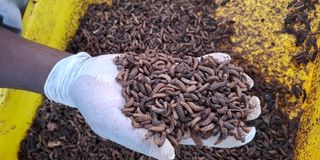How to set up a productive Black Soldier Fly farm

Black Soldier Fly larvae (in the pre-pupa and pupa stage).
Establishing a Black Soldier Fly (BSF) farm can be a profitable and sustainable business, especially as the demand for alternative sources of protein and organic fertiliser continues to grow.
Setting up a BSF unit requires planning, research and investment in the right equipment.
To get started, it's important to gather general information and learn from others who are already doing it.
The best way to do this is to visit existing BSF farms. This will allow you to see first-hand how things work, where they source their raw materials, how they manage their colonies, the challenges they've faced and the solutions they've implemented.
Institutions such as the International Centre of Insect Physiology and Ecology (ICIPE) offer free training programmes and starter kits, a great resource for beginners.
Location
To start you need an ideal location.BSF larvae thrive in a warm, humid and well-ventilated environment.
Your unit should be set up in a shaded area where the temperature stays between 25°C and 35°C, the optimum temperature for fly activity.
If you're setting up on a small scale, an unused corner of your garden or backyard will work well. It's important that the area is easily accessible for maintenance and has sufficient ventilation to prevent the build-up of harmful gases.
For the structure, you could start with a small greenhouse, such as one that measures 8x15 feet, which will help regulate the temperature and humidity levels that are crucial for BSF activity.
You can also opt for a more affordable structure, such as a small wooden frame or temporary structure if you're on a budget.
Make sure your structure has a good level of shade to protect your flies and larvae from direct sunlight. Proper shading will keep the temperature stable and prevent it from getting too hot for the BSF flies and larvae. The structure should also be well ventilated, as airflow is important for healthy BSF growth.
Next you will need a love cage in which the adult BSF can mate and lay eggs. It must be large enough for the flies to mate in flight. The ideal size for a mating box and net is about 3 feet by 2.5 feet.

An ovitrap made of wood where a female Black Soldier Fly lays its eggs.
Also ensure the cage is in an area with adequate light. You will need an attractant (which may have a slightly unpleasant smell) to lure the flies into the love cage. The attractant will encourage the flies to enter and lay their eggs.
The 'eggs' or egg-laying area can be made of wood or cardboard and should be designed to encourage the flies to lay their eggs.
For small-scale operations, a container about 1 metre long, 0.5 metres wide and 0.3 metres deep should suffice. You can scale up depending on the size of your operation.
The containers must have drainage holes to allow excess moisture to escape and prevent the larvae from getting too wet. This will ensure a moist but not soggy environment.
Use a cover with holes or mesh to protect the larvae from pests while still allowing air to circulate.
For your larvae, you can use trays, which can cost between Sh550 and Sh800, or repurpose 20 litre plastic jerrycans of different colours.
Feeding system
BSF larvae thrive on a variety of organic materials such as food scraps, vegetable peels and dung. Chop these materials into small pieces to make them easier for the larvae to consume.
Add a layer of bedding material to the bottom of the container to absorb moisture and provide a comfortable environment for the larvae. Sawdust, straw or shredded paper are good options.

Dried Black Soldier Fly larvae ready to be mixed with feed for livestock consumption.
BSF larvae need a moist environment to thrive, so spray the mixture of organic waste and bedding with water regularly. Be careful not to over soak the materials - moisture is important, but standing water can harm the larvae.
For the initial set up, you may want to start with instar one (eggs) or instar five (pupae). These can be purchased from a reputable supplier for around Sh2000 to Sh3000 per kilogram.
Avoid giving them food that is too salty, oily or processed as this can harm the larvae.
Keep an eye on the temperature and humidity levels to ensure they remain within the ideal range (25°C to 35°C and high humidity). If necessary, adjust the ventilation or provide additional shade.
After about two weeks the larvae will reach full size and are ready to be harvested. At this stage they can be used as animal feed or processed into protein powder.
The larvae should be harvested carefully to avoid disturbing the rest of the colony.

Frass (Black Soldier Fly excrement) that serves as a nutrient rich organic fertilizer.
In addition to producing protein-rich larvae, the BSF unit will also produce frass rich in nitrogen, phosphorus and potassium, a nutrient-rich waste product that makes an excellent organic fertiliser.
After harvesting the larvae, collect the frass and store it for future use.
Keep at least 30% of the harvested larvae to maintain your colony. These remaining larvae will mature into adult flies and lay eggs, starting the next generation of larvae.
By keeping this cycle going, you won't need to constantly buy new larvae or eggs.
Most importantly, make sure you have a stable source of funding to support you through the business, a clear business plan and a ready market to sell your produce when it is ready.

